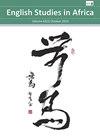Ancient Chinese Poetry and Chinese Calligraphy in Combatting COVID-19
IF 0.5
4区 文学
0 LITERATURE
引用次数: 0
Abstract
In the global fight against the COVID-19 pandemic, countries, regions and international organizations dispatched personal protective equipment (PPE) to frontline workers and afflicted people. Lines of ancient Chinese poetry were printed on the side of boxes dispatched by the People’s Republic of China both nationally and globally, as well as some sent from Japan to China. Many of these lines invoked shared histories and the long tradition of crosscultural communication and international friendship between China and other countries. But the printing of poetry was also motivated by a desire to remove people – albeit temporarily – from the context of COVID-19 suffering, to lead them to a more peaceful and harmonious world. The good will and friendship among people, as well as the common destiny of all humanity, is a recurrent theme. On the boxes of PPE sent to Wuhan, initially the most affected city, by the Chinese language academy (HSK) in Japan, eight Chinese characters read, ‘Mountain, River, Different, Areas / Wind, Moon, Same, Sky’ (Figure 1). The elemental and ethereal images, wind, moon and sky emblematize a lofty, magnanimous, and capacious mind, able to accommodate ‘ten thousand things’. These words were first embroidered on a thousand cassocks – on the orders of Japan’s Emperor Tenmu’s grandson Prince Nagaya (circa. 684–729) – and were sent to the Tang Dynasty court about 1300 years ago. After receiving them, the high monk Ganjin (Jianzhen 688–763), inspired by the gift, sailed to Japan to propagate Buddhism there. Invoking and rekindling this ancient memory of Japan reaching out – reiterating the gift – the HSK affirmed the long history of solidarity between the two nations. As the pandemic unfolded, China reciprocated the gift by sending PPE to Japan. China’s poem to Japan also affirmed their common heritage despite the distance separating them. The Tiantai Sect was founded during the Tang Dynasty and Japanese monks traveled to Tiantai to study, which led to them establishing the Tiantai Sect in Japan and instigating ongoing exchange. The Buddhist scholar Juzan’s lines allude to this history by using the metaphor of a tree’s blossom spreading its fragrance to two places (Figure 3). In the lines by Southern Song Dynasty poet, Zhang Xiaoxiang (Figure 7), printed on the PPE中国古诗词和中国书法在抗击新冠肺炎中的作用
在全球抗击新冠肺炎疫情的过程中,各国、各地区和国际组织纷纷向疫情防控一线工作人员和患者派发个人防护装备。中国古代诗词的诗句被印在中华人民共和国在国内和全球发送的盒子上,以及一些从日本发送到中国的盒子上。其中许多歌词表达了中国与其他国家之间共同的历史、跨文化交流的悠久传统和国际友谊。但是,诗歌的印刷也是出于一种愿望,即让人们(尽管是暂时的)摆脱COVID-19苦难的背景,带领他们走向一个更加和平与和谐的世界。人们之间的善意和友谊,以及全人类的共同命运,是一个反复出现的主题。日本汉语水平考试中心(HSK)寄往受灾最严重的城市武汉的防护用品包装盒上,有“山、河、异、区/风、月、同、天”八个汉字(图1)。风、月、天这些素雅而空灵的形象,象征着一颗高远、宽宏大量、能容“万物”的胸怀。这句话最初被绣在一千件袈裟上——这是日本天武天皇的孙子长屋亲王(大约在公元2000年)的命令。684-729)——大约1300年前被送到唐朝朝廷。高僧甘津(688-763)收到礼物后,受此启发,乘船前往日本,在那里传播佛教。汉语水平考试唤起并重新点燃了日本伸出援手的古老记忆,重申了中国对中国的厚爱,肯定了中日两国悠久的团结历史。随着疫情的发展,中国回赠了日本个人防护装备。中国给日本的诗也肯定了他们的共同遗产,尽管他们相隔遥远。天台宗成立于唐代,日本僧人前往天台学习,导致他们在日本建立了天台宗,并不断进行交流。佛教学者朱赞(Juzan)的诗句以“一树之花,花香四溢”的比喻来影射这段历史(图3)。印在PPE上的南宋诗人张孝祥的诗句(图7)
本文章由计算机程序翻译,如有差异,请以英文原文为准。
求助全文
约1分钟内获得全文
求助全文

 求助内容:
求助内容: 应助结果提醒方式:
应助结果提醒方式:


